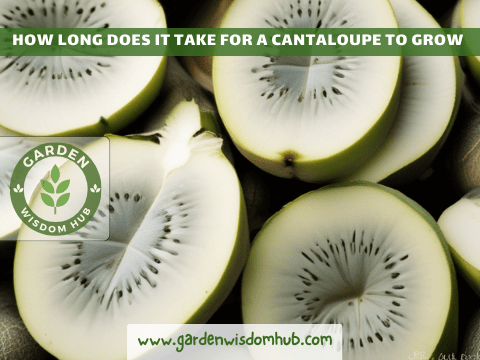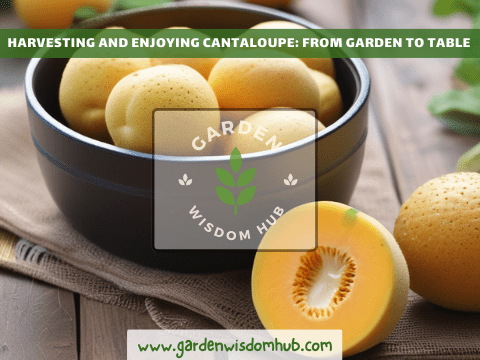Cantaloupe season:
In the world of farming, cantaloupe plants successfully grow from seeds to vines in just one planting cantaloupe season The moment where they are planted, a natural growth process occurs, representing nature guiding each step for their perfect growth. Also, the waiting time for the complete growth process is not that short, they take around 75 days from the process of planting to harvesting, creating a consistent supply of delicious cantaloupes.
When do I pick my cantaloupe?
Cantaloupes picking is just like a special dance, with each fruit cautiously taken from the vine by skilled harvesters. These workers respect nature’s timing as well and avoid the use of any machines, they perfectly know when are cantaloupes ready to pick. Cantaloupes are at their top when they ripen naturally under the sun, so the harvesters hunt for them like flavor adventurers in the fields.
How to tell when to pick cantaloupe?
In the USA, the harvesters just know how to spot a ripe melon, by the use of their fingers and eyes to find the matured ones and leave the rest for their maturity. Although different types of cantaloupes have different clues for ripeness, so only the finest fruits are collected in the buckets by the harvesters.
When are cantaloupes ready to be picked?
When to harvest cantaloupe melons is a question that comes into the minds of many people. Cantaloupe harvesters follow a tradition that has been passed down through generations, In the fields of ripening, a team works with love, care, and skills observing the pulse of the land.
They go across the rows with keen vision and nimble hands, like guardians of the crop. Other members of the team are waiting to assist with the delicate task beside the tall harvesting equipment.
- Watch this YouTube Video For More Guide Related to Cantaloupe Growing & Harvesting
How to grow a cantaloupe?
When cantaloupes grow in the beautiful sunshine spreading all over the fields, the mystery of ripeness unfolds. From planting the seeds, the level of hope as well as excitement for the plentiful harvest increases. Sun’s warmth plays a major role in the growth and ripeness of melons, making them sweeter and fuller.
How to know when to harvest cantaloupe:
If you want to know when I harvest cantaloupe, focus on the nature. Nature gives subtle cues when something is ready. A hint of the sweetness to come is in the air, as the scent of ripening fruit fills the space. As time passes, the cantaloupes change. Their tough, green skin softens and turns golden, showing they’re ripe. When the tendrils around them dry out, it’s time to harvest them.
Where do cantaloupes come from?
In the busy packing area, the focus shifts from harvesting to categorizing and packing. The fresh cantaloupes are getting ready for their next phase and are placed on solid tables. Workers move rapidly and deliberately, gathering around with nimble hands.
When the melons are placed on the table, the packers begin to work right away. They identify each fruit expertly, tracing its journey from the vine to the table. They evaluate each melon with keen eyes, grouping them into appropriate-sized boxes. Fitting the larger melons into boxes designed for them and the smaller ones into containers that precisely match their sizes is like completing a puzzle.
The packers sound the tape like the last note in a harvest symphony as they seal each box tightly after it is filled. Carefully placed labeling makes sure that every package has a unique origin narrative to share. The boxes are then carried to the following trailer, where pallets are waiting to accept them, with a feeling of accomplishment.
- Read up on our comprehensive article about Understanding Cantaloupe Growth Stages and Care
Another guardian keeps an eye on the cool trailer: the labeler, who is prepared to keep track of every box’s path for traceability. A cautious hand labels the boxes as they pass, indicating their journey. The products of the harvest start their next journey once every box has been recorded illustrating the harmonious relationship of human care and the richness of nature.
As the full trailer of harvested fruits arrives at the nearby cooler, excitement fills the air, mixing with the refreshing breeze promising freshness. In this space filled with shiny machines and tall shelves, the next part of the harvest story begins. Pallets carrying boxes are skillfully maneuvered towards the center of the cooler, where a forced air chilling system is waiting. The huge quantity of melon is nicely preserved by the chilly air surrounding it.
The pallets are then carefully positioned onto the storage shelves, an example of brilliant engineering, all with a soft sound.
How long does it take for a cantaloupe to grow

Cantaloupe also has another name muskmelon. It originates from the species Cucumis melo var. cantaloupes are used by millions of people due to the variety of benefits they offer to the public. It’s not only juicy and known for its sweet flesh but also contains a highly refreshing flavor.
A lot of people in the USA love to regularly use cantaloupe plants in their routine salads, pastries, and snacks. These foods can be taken during summer. There are higher chances that you can upgrade your gardening level and cooking experience just by gaining proper knowledge about the process of harvesting.
Additionally, cultivating cantaloupes in your garden can be a gratifying experience in and of itself.1 Developing and Providing Support Cantaloupes, which are fruits that ripen during the warmer months, thrive on soil that is well-drained and receives enough sunlight. The use of mulch helps to keep moisture in the soil, and it requires frequent watering, especially when the temperature is higher.
Because their vines are capable of covering a large amount of area, cantaloupe plants require a great deal of space in which to develop to be successful.
- Read up on our comprehensive article about The Ultimate Guide to Cantaloupe plant growth stages
When to harvest a cantaloupe?
Cantaloupes are produced from flowers that require pollination by bees; therefore, it is essential to ensure that pollinators can enter your garden to achieve the desired result of setting fruit. The formation of the fruit and its maturation takes approximately eighty to ninety days.
If it is time to harvest, when is it? To acquire the most flavorful and ripe cantaloupes possible, there are a few things you need to know to get the most out of them.
- Read up on our comprehensive article about The Complete Guide to Cantaloupe: Facts, Growing, and Varieties
How do you know when to harvest cantaloupe?
When is the appropriate moment to make a selection?
When the webbing is present, the hue of the skin of a cantaloupe shifts from green to yellowish or brown color with a transition in between.
- Does the skin have a gentle texture?
- Does it seem like the fruit is heavy?
- Does the fruit have a pleasant aroma?
It is recommended that the fruit be stored in the refrigerator for a couple of days at room temperature once it has been collected.
You may enjoy cantaloupe in a wide variety of different ways because it is a fruit that is flexible. What about demanding a dessert that is both nutritious and delicious? Yes, you might want to consider making a smoothie. You can make it using a blend of yogurt, honey, and ice cubes.
Cut the stem off of the fruit that is just above it and connect a small stub to it so that you can harvest it. Check to see that neither it nor the vine is harmed. You can keep it for a couple of days at room temperature after harvesting it, or you can keep it in the refrigerator for a longer time. You can savor it on its own, or you can enhance its flavor by adding honey or salt. If you want to consume it in its fresh state, you must first split the fruit in half and then remove the seeds using a spoon. The meat can then be sliced into slices or wedges in the following step.
- Read up on our comprehensive article about Cantaloupe and Watermelon: Growing Tips and Differences
Health Benefits
In addition to its delicious taste, it is rich in many beneficial elements for the body. The cantaloupe plant is filled with nutrients required by human beings, such as potassium, vitamin A, vitamin C, and fiber. For the Goal of Preparing Food In addition to being a delicious pickle eaten straight from the jar, it has a wide range of culinary uses and may be incorporated into many other dishes. This ingredient might enhance the flavor of sorbet, fruit salad, or even baked desserts when added to these dishes. Salsas and relishes, for instance, could benefit from its sweetness and heat. You could use it for either purpose.
Cantaloupe is a tasty fruit that many people find pleasant in their unique ways. You can drink the juice straight from the juicer or add sugar and spices to make a smoothie. Jam and preserves can also be made with it. Plus, it can be used to make jams and jellies. Therefore, you have landed on the right page with this post if you are seeking an approach to maximize the yield of cantaloupes that you have cultivated in your garden. Following these guidelines will allow you to produce and harvest cantaloupes, which will provide you with delicious fruit for many years to come.
FAQs
Are cantaloupes in season?
The season of cantaloupes begins from June through August. At this time, they are at their peak of beauty and taste.
How long does a cantaloupe take to grow? Or How long does it take to grow a cantaloupe?
The formation of the fruit and its maturation takes approximately eighty to ninety days.
————————————————————————————————————————————————————-
To learn more about Kitchen Garden Check out Our Guides:
Life Cycle of a Strawberry Plant Exploring the Complete Details
Strawberry Plant Growth Stages The Ultimate Complete Guide
Why are My Basil Leaves Turning Brown?
Guide to Banana Plant Growth Stages
Guide To an Apple Tree Growth Stages
Guide to Turmeric Plant Growth Stages
Guide to Cherry Tomatoes Growth Stages
James Porter
Welcome to our haven of gardening and plant care, where outdoor and indoor planting enthusiasts come together! At Gardening Wisdom Hub, we aim to provide you with the most authentic information on anything related to gardening, plant care, seasonal planting etc.
The author of our website is James Porter, an experienced industry veteran. He has a deep interest in everything green. James’s enthusiasm for exploring plants’ features and learning new gardening methods began at a young age. Gradually, his passion increased with time, leading him to become a highly esteemed professional. His extensive knowledge makes him a priceless resource for inexperienced and seasoned gardeners.

